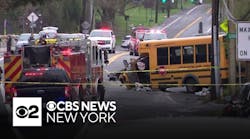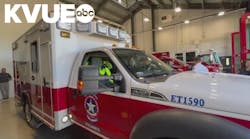June 13--The Jaroso Fire burning in the Pecos Wilderness is growing fast and will keep on growing, as there is plenty of fuel in its path and fire officials say that right now they can do little to suppress it.
Heavy smoke has thwarted air attacks since Monday afternoon when the fire was first reported. Fire crews can't get into the area for the same reason and because the blaze is burning in such a remote area that access is not easy.
Duane Archuleta, fire management officer for the Santa Fe National Forest, said about 15 firefighters were brought in by air soon after the fire started.
"When they saw how the fire was behaving and because there are no safety zones, we had to get them out of there," he said.
What was a 2- or 3-acre fire when it was first detected about 6 miles southeast of Bor- rego Mesa on Monday grew to 20 acres in the first 45 minutes, he said. It grew to close to 2,000 acres after 24 hours, and by Tuesday morning was estimated to be about 8,000 acres.
Archuleta said the fire was burning so hot Tuesday night that it interfered with sensors on the plane that flies over the fire to take infrared pictures, making it difficult to get an accurate measure of the fire's size.
"In terms of the fire here, we've never seen one of this scale," said Sandy Hurlocker, SFNF's Espanola District ranger.
Hurlocker said while they have no way to accurately determine how long it has been since a fire has burned through most of the Pecos Wilderness, it has probably been at least a couple of hundred years.
And, it's difficult to predict how the fire will react, because there's nothing to compare it with.
"We had the Las Conchas Fire two years ago, but this at such a high elevation it's not the same as Las Conchas," he said.
The Jaroso Fire is burning in terrain at about 10,000 feet. While there's generally more moisture present at that elevation, drought conditions have dried things out. Live fuel moisture in trees such as ponderosa pine is below normal, he said.
"What that means is when they start burning they end up torching and you have crown fires running from tree to tree, and that's impossible to stop," he said.
In a wilderness area not subject to forest thinning or prescribed burns, heavy amounts of fuel exist. The Pecos Wilderness covers nearly 225,000 acres, so the potential is there for this fire to spread and for smoke to impact communities downwind from the blaze, such as Mora and Holman.
While firefighters are in full suppression mode, conditions are preventing much of anything being done.
"Our concern on this fire is that even though it's doing what comes natural in the wilderness, the question is what happens if it goes outside the wilderness do we want to accept what happens then? Right now, we're saying no," Hurlocker said.
The fire is in such a remote area, no structures or communities are being threatened. The nearest homes are located in areas surrounding Truchas, Las Trampas and Penasco 10 miles or more to the north and northwest. They aren't believed to be in the path of the fire, which has been moving northeast and east.
While human populations aren't threatened, Hurlocker said there are Rocky Mountain bighorn sheep in the high country and Rio Grande cutthroat trout, some of which have already been relocated for precautionary reasons to preserve their strain, in the upper Pecos River.
"As the fire moves through timber it might not affect the streams directly, but when is starts to rain there will be runoff that could have an impact," he said.
Archuleta, the fire management officer, said he expected the blaze to burn east around the south side of Pecos Baldy and make another run in that direction toward Trailriders Wall.
There's also 1,300 acres of downed timber due to a wind event six years ago. Much of that area burned Tuesday, but Archuleta said he expected a part of the fire to spread southwest as it consumed more of the downed trees.
Farther in that direction is the burn scar from the 2011 Pacheco Fire.
"At least we have something to work with with that burn scar," Archuleta said.
While it was too risky to get fire crews on the ground Wednesday, Archuleta said they'd like to get some in as soon it was deemed safe.
"We need to get out ahead of it and start mitigation efforts," he said, adding that those would include preparing access roads and fire lines.
District Ranger Hurlocker said there could be some longterm benefits to the wilderness with the fire burning through, allowing the forest to rejuvenate itself naturally. In this case, however, fire officials want to keep it from spreading toward communities.
But with conditions being the way they are, efforts are on hold. About all the incident command team can do now is work on a strategy to attack the blaze when crews are able to get in.
"Sometimes suppression means we have to step back and weigh the whole picture," Hurlocker said. "It may look like we're not doing anything, but we're just looking for the right opportunity to suppress it. Conditions are so dangerous, we want to make sure we're getting it right."
Copyright 2013 - Albuquerque Journal, N.M.





